文章目录
前言
DCNv3在DCNv2版本上进行了改进,上一期我们在YOLOv8中添加了DCNv2,这一期我们将添加DCNv3,DCNv3代码详解可以参考链接: 代码详解——可变形卷积(DCNv3)
一、YOLOv8原始版本代码下载
源码下载地址 :链接: link
源码提取码: rpe7
二、DCNv3代码
import warnings
import torch
from torch import nn
import torch.nn.functional as F
from torch.nn.init import xavier_uniform_, constant_
def _get_reference_points(spatial_shapes, device, kernel_h, kernel_w, dilation_h, dilation_w, pad_h=0, pad_w=0,
stride_h=1, stride_w=1):
_, H_, W_, _ = spatial_shapes
H_out = (H_ - (dilation_h * (kernel_h - 1) + 1)) // stride_h + 1
W_out = (W_ - (dilation_w * (kernel_w - 1) + 1)) // stride_w + 1
ref_y, ref_x = torch.meshgrid(
torch.linspace(
(dilation_h * (kernel_h - 1)) // 2 + 0.5,
(dilation_h * (kernel_h - 1)) // 2 + 0.5 + (H_out - 1) * stride_h,
H_out,
dtype=torch.float32,
device=device),
torch.linspace(
(dilation_w * (kernel_w - 1)) // 2 + 0.5,
(dilation_w * (kernel_w - 1)) // 2 + 0.5 + (W_out - 1) * stride_w,
W_out,
dtype=torch.float32,
device=device))
ref_y = ref_y.reshape(-1)[None] / H_
ref_x = ref_x.reshape(-1)[None] / W_
ref = torch.stack((ref_x, ref_y), -1).reshape(
1, H_out, W_out, 1, 2)
return ref
def _generate_dilation_grids(spatial_shapes, kernel_h, kernel_w, dilation_h, dilation_w, group, device):
_, H_, W_, _ = spatial_shapes
points_list = []
x, y = torch.meshgrid(
torch.linspace(
-((dilation_w * (kernel_w - 1)) // 2),
-((dilation_w * (kernel_w - 1)) // 2) +
(kernel_w - 1) * dilation_w, kernel_w,
dtype=torch.float32,
device=device),
torch.linspace(
-((dilation_h * (kernel_h - 1)) // 2),
-((dilation_h * (kernel_h - 1)) // 2) +
(kernel_h - 1) * dilation_h, kernel_h,
dtype=torch.float32,
device=device))
points_list.extend([x / W_, y / H_])
grid = torch.stack(points_list, -1).reshape(-1, 1, 2). \
repeat(1, group, 1).permute(1, 0, 2)
grid = grid.reshape(1, 1, 1, group * kernel_h * kernel_w, 2)
return grid
def dcnv3_core_pytorch(
input, offset, mask, kernel_h,
kernel_w, stride_h, stride_w, pad_h,
pad_w, dilation_h, dilation_w, group,
group_channels, offset_scale):
input = F.pad(
input,
[0, 0, pad_h, pad_h, pad_w, pad_w])
N_, H_in, W_in, _ = input.shape
_, H_out, W_out, _ = offset.shape
ref = _get_reference_points(
input.shape, input.device, kernel_h, kernel_w, dilation_h, dilation_w, pad_h, pad_w, stride_h, stride_w)
grid = _generate_dilation_grids(
input.shape, kernel_h, kernel_w, dilation_h, dilation_w, group, input.device)
spatial_norm = torch.tensor([W_in, H_in]).reshape(1, 1, 1, 2). \
repeat(1, 1, 1, group * kernel_h * kernel_w).to(input.device)
sampling_locations = (ref + grid * offset_scale).repeat(N_, 1, 1, 1, 1).flatten(3, 4) + \
offset * offset_scale / spatial_norm
P_ = kernel_h * kernel_w
sampling_grids = 2 * sampling_locations - 1
input_ = input.view(N_, H_in * W_in, group * group_channels).transpose(1, 2). \
reshape(N_ * group, group_channels, H_in, W_in)
sampling_grid_ = sampling_grids.view(N_, H_out * W_out, group, P_, 2).transpose(1, 2). \
flatten(0, 1)
sampling_input_ = F.grid_sample(
input_, sampling_grid_, mode='bilinear', padding_mode='zeros', align_corners=False)
mask = mask.view(N_, H_out * W_out, group, P_).transpose(1, 2). \
reshape(N_ * group, 1, H_out * W_out, P_)
output = (sampling_input_ * mask).sum(-1).view(N_,
group * group_channels, H_out * W_out)
return output.transpose(1, 2).reshape(N_, H_out, W_out, -1).contiguous()
class to_channels_first(nn.Module):
def __init__(self):
super().__init__()
def forward(self, x):
return x.permute(0, 3, 1, 2)
class to_channels_last(nn.Module):
def __init__(self):
super().__init__()
def forward(self, x):
return x.permute(0, 2, 3, 1)
def build_norm_layer(dim,
norm_layer,
in_format='channels_last',
out_format='channels_last',
eps=1e-6):
layers = []
if norm_layer == 'BN':
if in_format == 'channels_last':
layers.append(to_channels_first())
layers.append(nn.BatchNorm2d(dim))
if out_format == 'channels_last':
layers.append(to_channels_last())
elif norm_layer == 'LN':
if in_format == 'channels_first':
layers.append(to_channels_last())
layers.append(nn.LayerNorm(dim, eps=eps))
if out_format == 'channels_first':
layers.append(to_channels_first())
else:
raise NotImplementedError(
f'build_norm_layer does not support {norm_layer}')
return nn.Sequential(*layers)
def build_act_layer(act_layer):
if act_layer == 'ReLU':
return nn.ReLU(inplace=True)
elif act_layer == 'SiLU':
return nn.SiLU(inplace=True)
elif act_layer == 'GELU':
return nn.GELU()
raise NotImplementedError(f'build_act_layer does not support {act_layer}')
def _is_power_of_2(n):
if (not isinstance(n, int)) or (n < 0):
raise ValueError(
"invalid input for _is_power_of_2: {} (type: {})".format(n, type(n)))
return (n & (n - 1) == 0) and n != 0
class CenterFeatureScaleModule(nn.Module):
def forward(self,
query,
center_feature_scale_proj_weight,
center_feature_scale_proj_bias):
center_feature_scale = F.linear(query,
weight=center_feature_scale_proj_weight,
bias=center_feature_scale_proj_bias).sigmoid()
return center_feature_scale
class DCNv3_pytorch(nn.Module):
def __init__(
self,
channels=64,
kernel_size=3,
dw_kernel_size=None,
stride=1,
pad=1,
dilation=1,
group=4,
offset_scale=1.0,
act_layer='GELU',
norm_layer='LN',
center_feature_scale=False):
super().__init__()
if channels % group != 0:
raise ValueError(
f'channels must be divisible by group, but got {channels} and {group}')
_d_per_group = channels // group
dw_kernel_size = dw_kernel_size if dw_kernel_size is not None else kernel_size
# you'd better set _d_per_group to a power of 2 which is more efficient in our CUDA implementation
if not _is_power_of_2(_d_per_group):
warnings.warn(
"You'd better set channels in DCNv3 to make the dimension of each attention head a power of 2 "
"which is more efficient in our CUDA implementation.")
self.offset_scale = offset_scale
self.channels = channels
self.kernel_size = kernel_size
self.dw_kernel_size = dw_kernel_size
self.stride = stride
self.dilation = dilation
self.pad = pad
self.group = group
self.group_channels = channels // group
self.offset_scale = offset_scale
self.center_feature_scale = center_feature_scale
self.dw_conv = nn.Sequential(
nn.Conv2d(
channels,
channels,
kernel_size=dw_kernel_size,
stride=1,
padding=(dw_kernel_size - 1) // 2,
groups=channels),
build_norm_layer(
channels,
norm_layer,
'channels_first',
'channels_last'),
build_act_layer(act_layer))
self.offset = nn.Linear(
channels,
group * kernel_size * kernel_size * 2)
self.mask = nn.Linear(
channels,
group * kernel_size * kernel_size)
self.input_proj = nn.Linear(channels, channels)
self.output_proj = nn.Linear(channels, channels)
self._reset_parameters()
if center_feature_scale:
self.center_feature_scale_proj_weight = nn.Parameter(
torch.zeros((group, channels), dtype=torch.float))
self.center_feature_scale_proj_bias = nn.Parameter(
torch.tensor(0.0, dtype=torch.float).view((1,)).repeat(group, ))
self.center_feature_scale_module = CenterFeatureScaleModule()
def _reset_parameters(self):
constant_(self.offset.weight.data, 0.)
constant_(self.offset.bias.data, 0.)
constant_(self.mask.weight.data, 0.)
constant_(self.mask.bias.data, 0.)
xavier_uniform_(self.input_proj.weight.data)
constant_(self.input_proj.bias.data, 0.)
xavier_uniform_(self.output_proj.weight.data)
constant_(self.output_proj.bias.data, 0.)
def forward(self, input):
"""
:param query (N, H, W, C)
:return output (N, H, W, C)
"""
input = input.permute(0, 2, 3, 1)
N, H, W, _ = input.shape
x = self.input_proj(input)
x_proj = x
x1 = input.permute(0, 3, 1, 2)
x1 = self.dw_conv(x1)
offset = self.offset(x1)
mask = self.mask(x1).reshape(N, H, W, self.group, -1)
mask = F.softmax(mask, -1).reshape(N, H, W, -1)
x = dcnv3_core_pytorch(
x, offset, mask,
self.kernel_size, self.kernel_size,
self.stride, self.stride,
self.pad, self.pad,
self.dilation, self.dilation,
self.group, self.group_channels,
self.offset_scale)
if self.center_feature_scale:
center_feature_scale = self.center_feature_scale_module(
x1, self.center_feature_scale_proj_weight, self.center_feature_scale_proj_bias)
# N, H, W, groups -> N, H, W, groups, 1 -> N, H, W, groups, _d_per_group -> N, H, W, channels
center_feature_scale = center_feature_scale[..., None].repeat(
1, 1, 1, 1, self.channels // self.group).flatten(-2)
x = x * (1 - center_feature_scale) + x_proj * center_feature_scale
x = self.output_proj(x).permute(0, 3, 1, 2)
return x
def autopad(k, p=None, d=1): # kernel, padding, dilation
"""Pad to 'same' shape outputs."""
if d > 1:
k = d * (k - 1) + 1 if isinstance(k, int) else [d * (x - 1) + 1 for x in k] # actual kernel-size
if p is None:
p = k // 2 if isinstance(k, int) else [x // 2 for x in k] # auto-pad
return p
class Conv(nn.Module):
"""Standard convolution with args(ch_in, ch_out, kernel, stride, padding, groups, dilation, activation)."""
default_act = nn.SiLU() # default activation
def __init__(self, c1, c2, k=1, s=1, p=None, g=1, d=1, act=True):
"""Initialize Conv layer with given arguments including activation."""
super().__init__()
self.conv = nn.Conv2d(c1, c2, k, s, autopad(k, p, d), groups=g, dilation=d, bias=False)
self.bn = nn.BatchNorm2d(c2)
self.act = self.default_act if act is True else act if isinstance(act, nn.Module) else nn.Identity()
def forward(self, x):
"""Apply convolution, batch normalization and activation to input tensor."""
return self.act(self.bn(self.conv(x)))
def forward_fuse(self, x):
"""Perform transposed convolution of 2D data."""
return self.act(self.conv(x))
class Bottleneck(nn.Module):
"""Standard bottleneck."""
def __init__(self, c1, c2, shortcut=True, g=1, k=(3, 3), e=0.5):
"""Initializes a bottleneck module with given input/output channels, shortcut option, group, kernels, and
expansion.
"""
super().__init__()
c_ = int(c2 * e) # hidden channels
self.cv1 = Conv(c1, c_, k[0], 1)
self.cv2 = DCNv3_pytorch(c2)
self.add = shortcut and c1 == c2
def forward(self, x):
"""'forward()' applies the YOLO FPN to input data."""
return x + self.cv2(self.cv1(x)) if self.add else self.cv2(self.cv1(x))
class C2f_DCNv3(nn.Module):
def __init__(self, c1, c2, n=1, shortcut=False, g=1, e=0.5):
super().__init__()
self.c = int(c2 * e) # hidden channels
self.cv1 = Conv(c1, 2 * self.c, 1, 1)
self.cv2 = Conv((2 + n) * self.c, c2, 1) # optional act=FReLU(c2)
self.m = nn.ModuleList(Bottleneck(self.c, self.c, shortcut, g, k=(3, 3), e=1.0) for _ in range(n))
def forward(self, x):
x = self.cv1(x)
x = x.chunk(2, 1)
y = list(x)
y.extend(m(y[-1]) for m in self.m)
return self.cv2(torch.cat(y, 1))
def forward_split(self, x):
y = list(self.cv1(x).split((self.c, self.c), 1))
y.extend(m(y[-1]) for m in self.m)
return self.cv2(torch.cat(y, 1))
三、在YOLOv8添加DCNv3代码
1.在modules目录下添加上述的DCNv3代码
在ultralytics/nn/modules目录下,新建一个文件名,我这里取名为DCNv3.py,把上面代码复制进去,如图所示
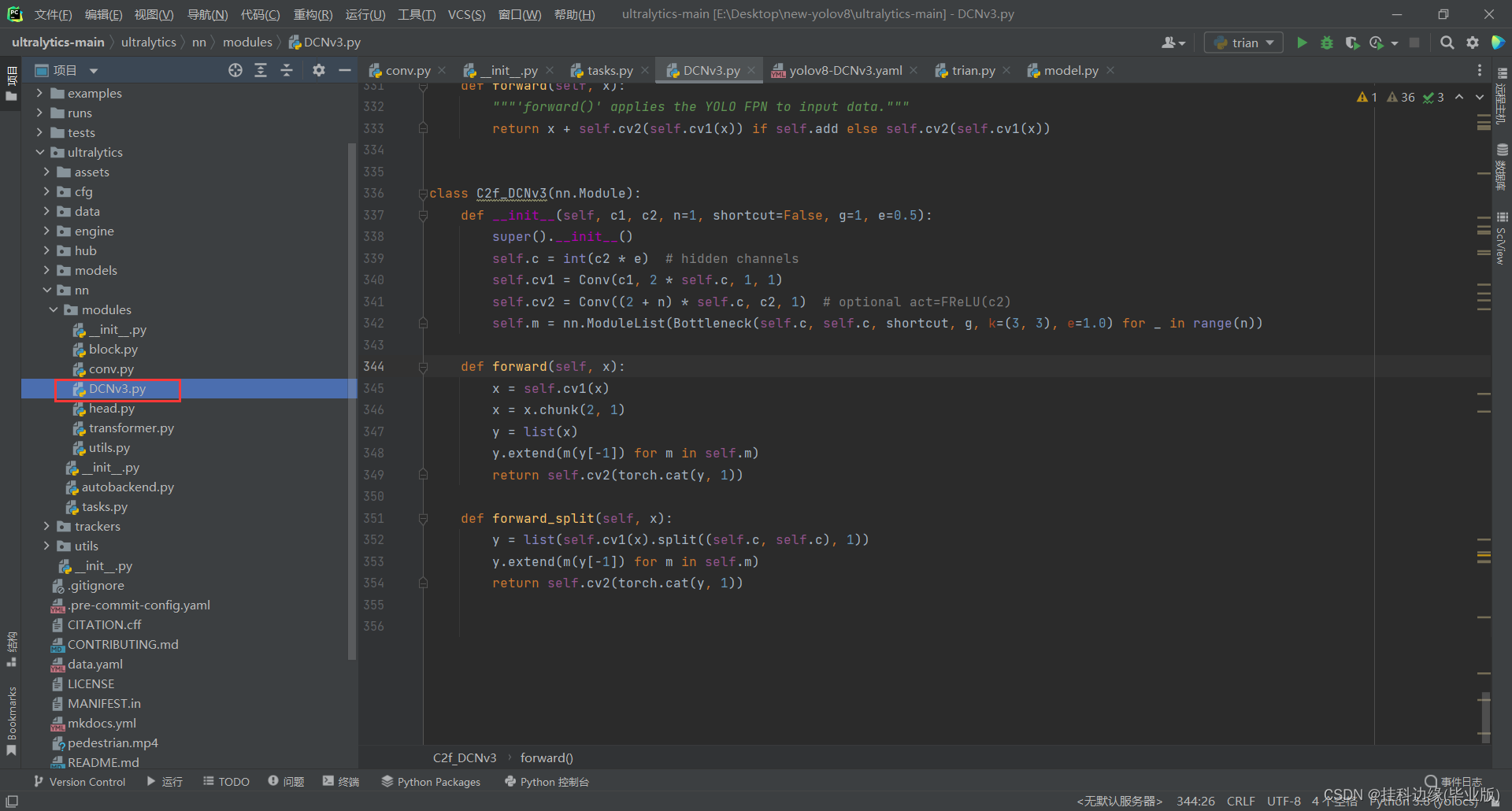
在__init__.py文件导入DCNv3模块,
文件路径为:ultralytics/nn/modules/init.py,在__init__.py开头导入DCNv3,导入截图所示
from .DCNv3 import *
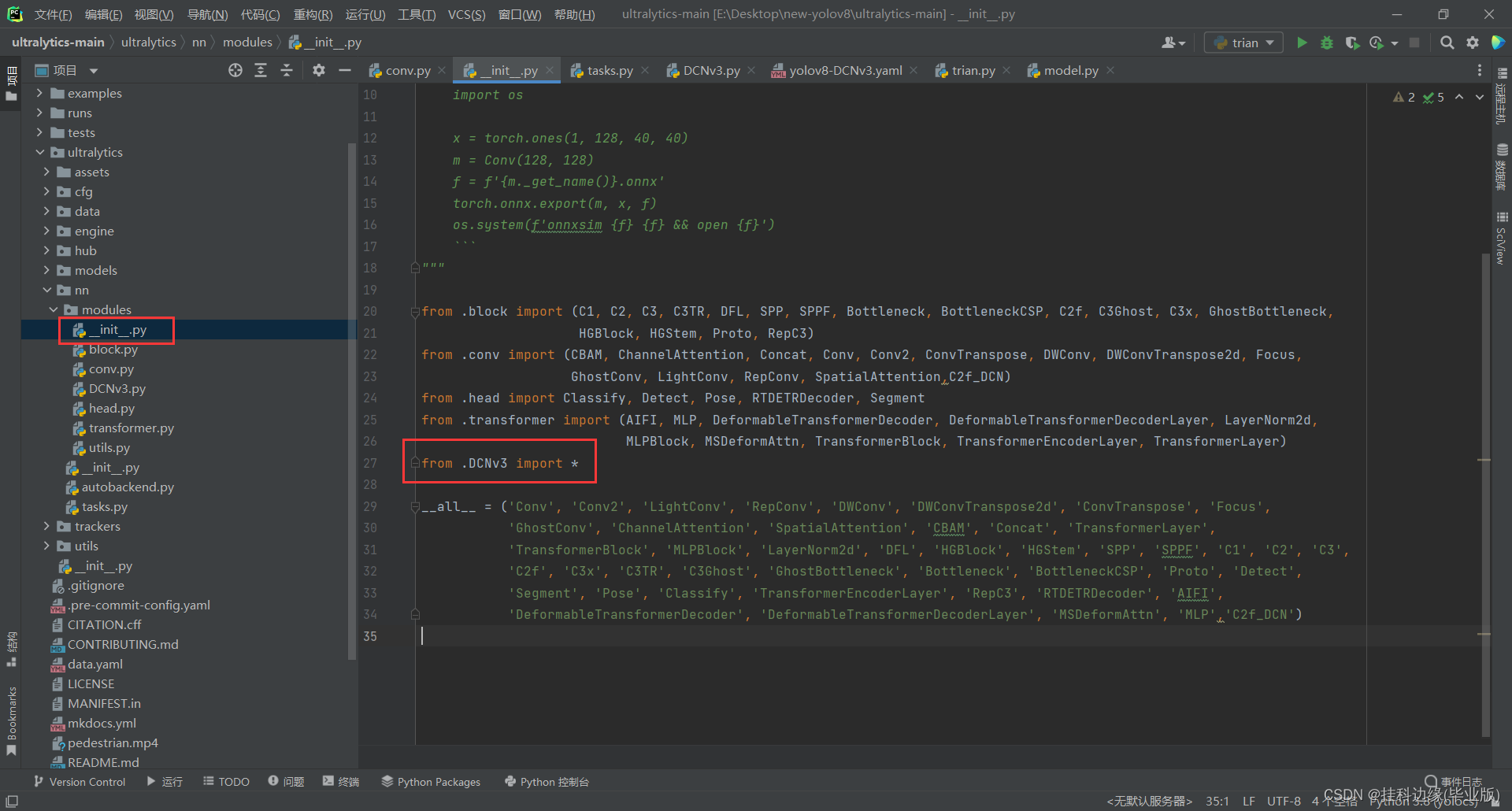
3.在tasks.py文件注册C2f_DCNv3
该文件路径为:ultralytics/nn/tasks.py,在开头导入C2f_DCNv3,添加如截图所示
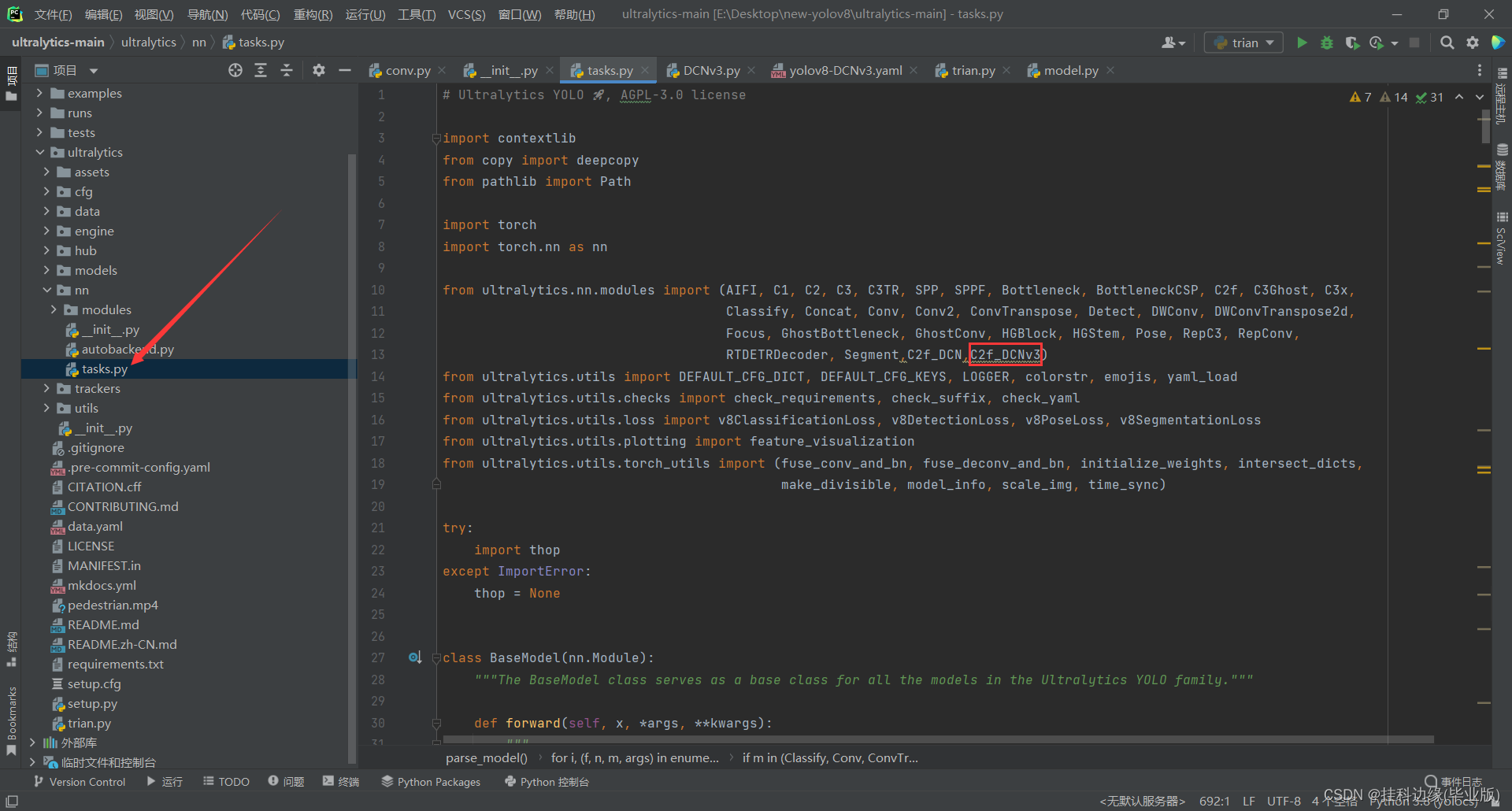
之后在这个文件的parse_model方法,添加C2f_DCNv3,添加如截图所示

看到这里已经成功添加进YOLOv8源码了,接下来配置yaml文件调用可变性卷积就行了
四、yaml文件修改
在ultralytics/cfg/models/v8目录下,新建一个yaml文件,复制yolov8.yaml文件,然后取名为yolov8-DCNv3.yaml,我这个文件代码如下所示:
我主要在主干网络把原始的cf2层替换成可变性卷积层,你也在其它地方修改,添加就行,还是多实验取涨点最大的就行
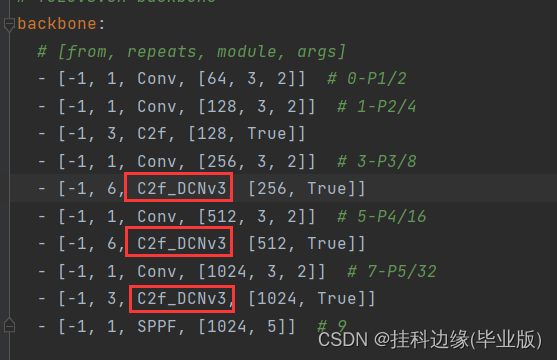
yolov8-DCNv3.yaml全部代码如下:
nc: 80 # number of classes
scales: # model compound scaling constants, i.e. 'model=yolov8n.yaml' will call yolov8.yaml with scale 'n'
# [depth, width, max_channels]
n: [0.33, 0.25, 1024] # YOLOv8n summary: 225 layers, 3157200 parameters, 3157184 gradients, 8.9 GFLOPs
s: [0.33, 0.50, 1024] # YOLOv8s summary: 225 layers, 11166560 parameters, 11166544 gradients, 28.8 GFLOPs
m: [0.67, 0.75, 768] # YOLOv8m summary: 295 layers, 25902640 parameters, 25902624 gradients, 79.3 GFLOPs
l: [1.00, 1.00, 512] # YOLOv8l summary: 365 layers, 43691520 parameters, 43691504 gradients, 165.7 GFLOPs
x: [1.00, 1.25, 512] # YOLOv8x summary: 365 layers, 68229648 parameters, 68229632 gradients, 258.5 GFLOPs
# YOLOv8.0n backbone
backbone:
# [from, repeats, module, args]
- [-1, 1, Conv, [64, 3, 2]] # 0-P1/2
- [-1, 1, Conv, [128, 3, 2]] # 1-P2/4
- [-1, 3, C2f, [128, True]]
- [-1, 1, Conv, [256, 3, 2]] # 3-P3/8
- [-1, 6, C2f_DCNv3, [256, True]]
- [-1, 1, Conv, [512, 3, 2]] # 5-P4/16
- [-1, 6, C2f_DCNv3, [512, True]]
- [-1, 1, Conv, [1024, 3, 2]] # 7-P5/32
- [-1, 3, C2f_DCNv3, [1024, True]]
- [-1, 1, SPPF, [1024, 5]] # 9
# YOLOv8.0n head
head:
- [-1, 1, nn.Upsample, [None, 2, 'nearest']]
- [[-1, 6], 1, Concat, [1]] # cat backbone P4
- [-1, 3, C2f, [512]] # 12
- [-1, 1, nn.Upsample, [None, 2, 'nearest']]
- [[-1, 4], 1, Concat, [1]] # cat backbone P3
- [-1, 3, C2f, [256]] # 15 (P3/8-small)
- [-1, 1, Conv, [256, 3, 2]]
- [[-1, 12], 1, Concat, [1]] # cat head P4
- [-1, 3, C2f, [512]] # 18 (P4/16-medium)
- [-1, 1, Conv, [512, 3, 2]]
- [[-1, 9], 1, Concat, [1]] # cat head P5
- [-1, 3, C2f, [1024]] # 21 (P5/32-large)
- [[15, 18, 21], 1, Detect, [nc]] # Detect(P3, P4, P5)
五、训练文件修改
YOLOv8训练方式跟YOLOv5是有区别的,但是训练数据集格式跟YOLOv5一样的,你只需把处理好的数据集就行,这里就不在阐述了,废话不多说,我的训练文件如下,根据你训练需求修改指定参数就行,圈起来的修改成你的路径就行
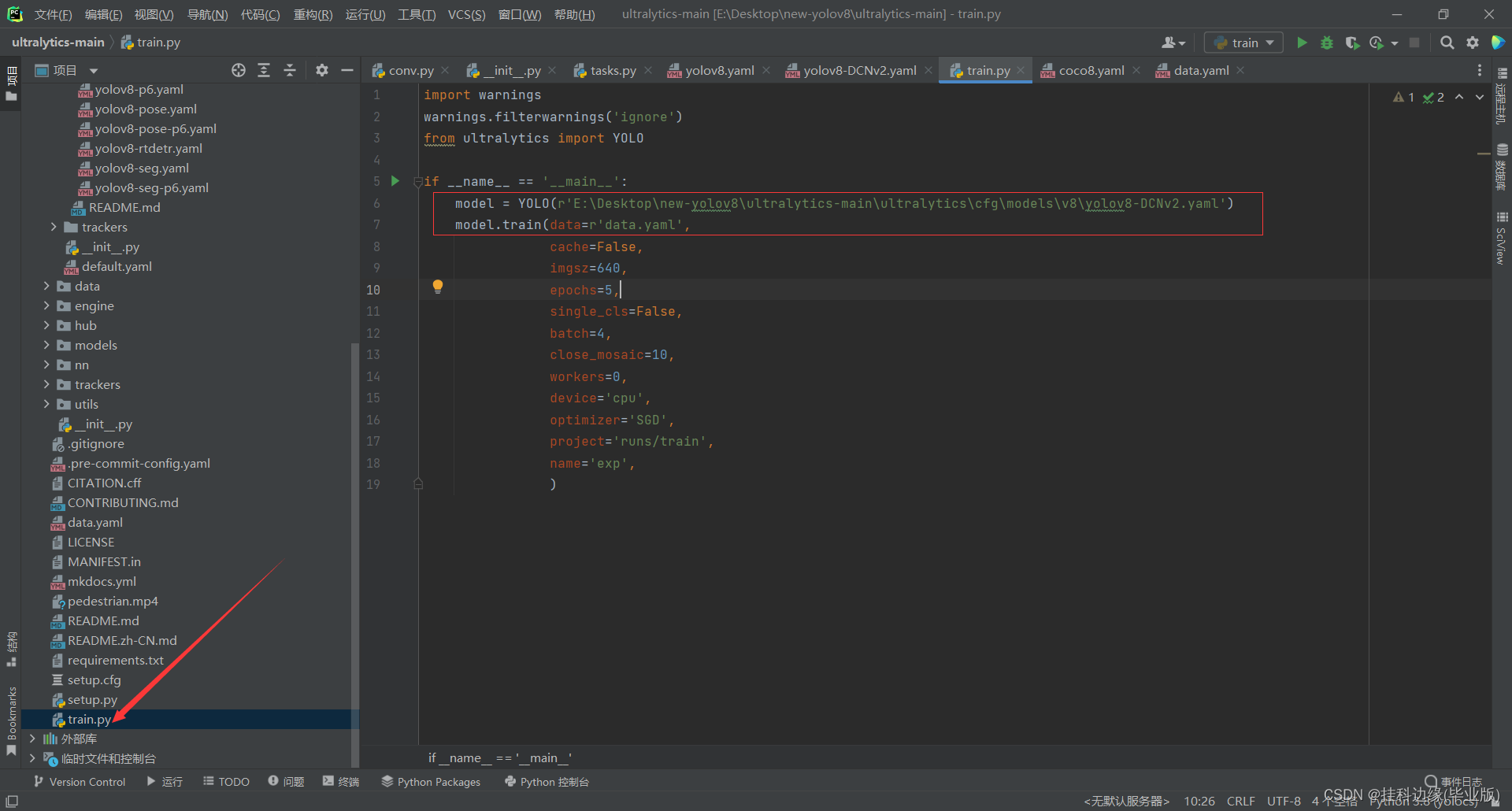
import warnings
warnings.filterwarnings('ignore')
from ultralytics import YOLO
if __name__ == '__main__':
model = YOLO(r'E:\Desktop\new-yolov8\ultralytics-main\ultralytics\cfg\models\v8\yolov8-DCNv2.yaml')
model.train(data=r'data.yaml',
cache=False,
imgsz=640,
epochs=5,
single_cls=False,
batch=4,
close_mosaic=10,
workers=0,
device='cpu',
optimizer='SGD',
project='runs/train',
name='exp',
)
device=‘cpu’,参数意思是:你电脑是GPU你就填0,CPU就填cpu,GPU是有英伟达显卡的电脑使用的,如果没有英伟达显卡训练非常慢,因为我电脑没有英伟达显卡,这里训练只用了几张数据集进行测试,你们也可以租云服务器训练,方法都是一样的,后期有空会出一起环境配置视频,我以前的作品也有环境配置教程的,你们可以翻一下看看
测试一下训练,打印出来的YOLOv8结构可以看到添加可变性卷积成功
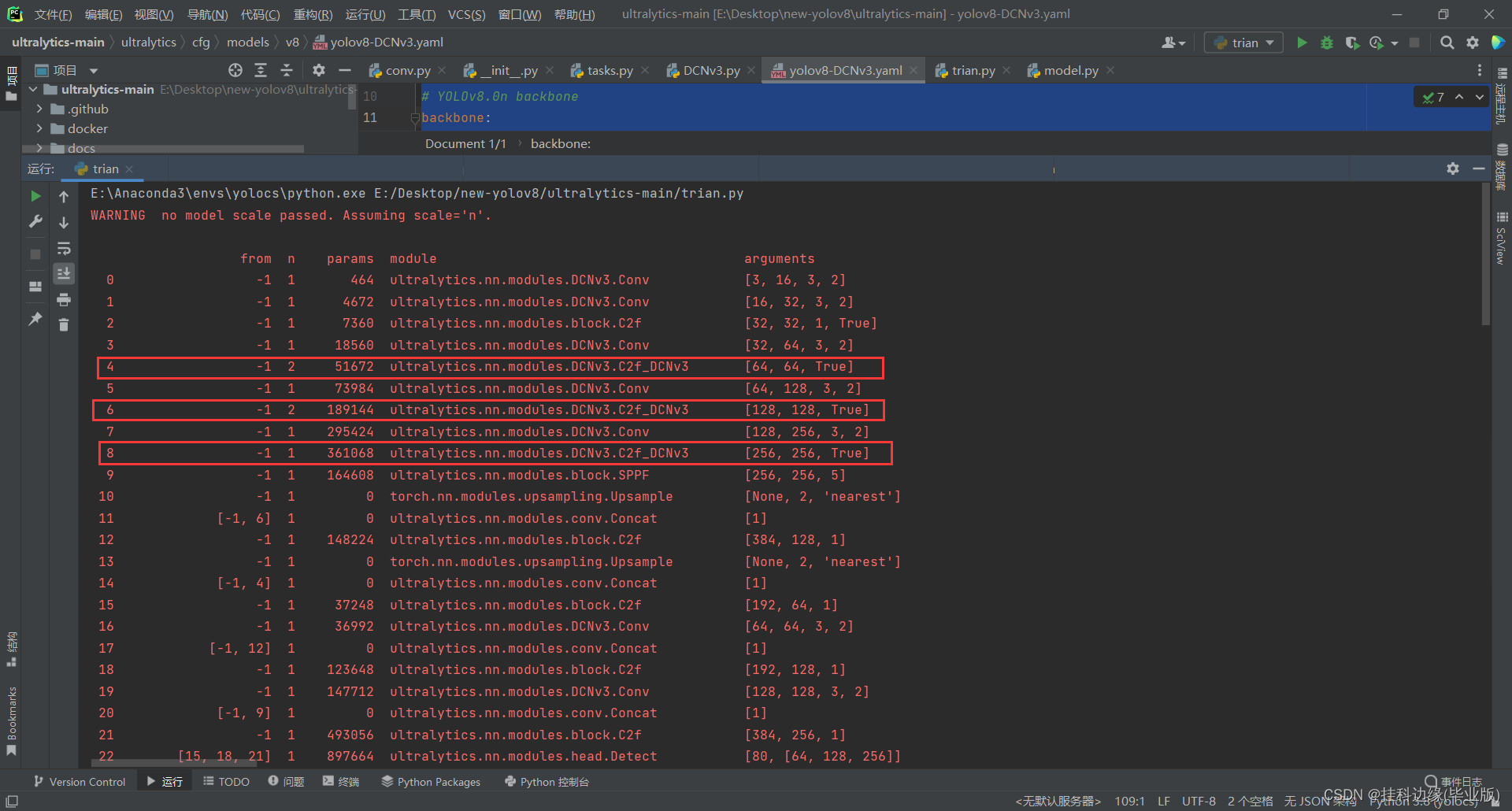
总结
请在我提供的YOLOv8代码修改,把环境配置好,数据集处理好,训练基本能成功,创作不易,请帮忙点一个爱心,谢谢观看
























 9312
9312











 被折叠的 条评论
为什么被折叠?
被折叠的 条评论
为什么被折叠?










